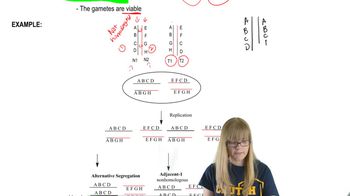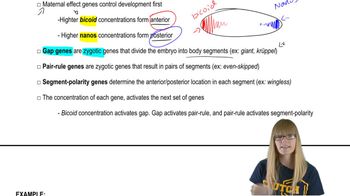Here are the essential concepts you must grasp in order to answer the question correctly.
Heterozygous Reciprocal Balanced Translocation
A heterozygous reciprocal balanced translocation occurs when two non-homologous chromosomes exchange segments, resulting in a rearrangement of genetic material without loss. In this scenario, one chromosome carries the original segments, while the other carries the exchanged segments. This can lead to unique segregation patterns during meiosis, affecting gamete viability and genetic diversity.
Recommended video:
Segregation Patterns
Segregation patterns refer to the ways in which chromosomes are distributed into gametes during meiosis. In the case of a heterozygous translocation, different segregation patterns can arise, including alternate, adjacent-1, and adjacent-2 segregation. Each pattern has different implications for the genetic composition of the resulting gametes, influencing the likelihood of producing viable offspring.
Recommended video:
Viability of Gametes
The viability of gametes is crucial in understanding the outcomes of different segregation patterns. In the context of a reciprocal balanced translocation, certain segregation patterns may produce gametes with unbalanced genetic material, leading to non-viable embryos. Typically, alternate segregation produces viable gametes, while adjacent segregation patterns are more likely to result in aneuploidy, making them less favorable.
Recommended video:
 Verified step by step guidance
Verified step by step guidance Verified video answer for a similar problem:
Verified video answer for a similar problem:



 12:42m
12:42m